American Revolution
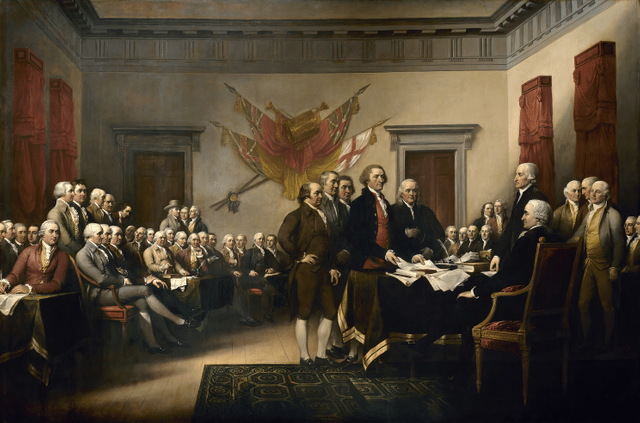
American Revolution

| Part of the Atlantic Revolutions | |
| Date | 1765–1783 |
|---|---|
| Location | Thirteen Colonies |
| Participants | Colonists in British America |
| Outcome |
|
The American Revolution was a colonial revolt which occurred between 1765 and 1783. The American Patriots in the Thirteen Colonies defeated the British in the American Revolutionary War (1775–1783) with the assistance of France, winning independence from Great Britain and establishing the United States of America.
The American colonials proclaimed "no taxation without representation" starting with the Stamp Act Congress in 1765. They rejected the authority of the British Parliament to tax them because they had no representatives in that governing body. Protests steadily escalated to the Boston Massacre in 1770 and the burning of the Gaspee in Rhode Island in 1772, followed by the Boston Tea Party in December 1773. The British responded by closing Boston Harbor and enacting a series of punitive laws which effectively rescinded Massachusetts Bay Colony's rights of self-government. The other colonies rallied behind Massachusetts, and a group of American Patriot leaders set up their own government in late 1774 at the Continental Congress to coordinate their resistance of Britain; other colonists retained their allegiance to the Crown and were known as Loyalists or Tories.
Tensions erupted into battle between Patriot militia and British regulars when King George's redcoats attempted to destroy Colonial military supplies at Lexington and Concord on April 19, 1775. The conflict then developed into war, during which the Patriots (and later their French allies) fought the British and Loyalists in what became known as the American Revolutionary War (1775–1783). Each of the thirteen colonies formed a Provincial Congress which assumed power from the former colonial governments, suppressed Loyalism, and recruited a Continental Army led by General George Washington. The Continental Congress declared King George a tyrant who trampled the colonists' rights as Englishmen, and they declared the colonies free and independent states on July 2, 1776. The Patriot leadership professed the political philosophies of liberalism and republicanism to reject monarchy and aristocracy, and they proclaimed that all men are created equal.
The Continental Army forced the redcoats out of Boston in March 1776, but that summer the British captured New York City and its strategic harbor, which they held for the duration of the war. The Royal Navy blockaded ports and captured other cities for brief periods, but they failed to destroy Washington's forces. The Patriots attempted to invade Canada during the winter of 1775–76 without success, but they captured a British army at the Battle of Saratoga in October 1777. France entered the war as an ally of the United States with a large army and navy. The war then moved to the Southern states, where Charles Cornwallis captured an army at Charleston, South Carolina in early 1780, but he failed to enlist enough volunteers from Loyalist civilians to take effective control of the territory. Finally, a combined American and French force captured a second British army at Yorktown in the fall of 1781, effectively ending the war. The Treaty of Paris was signed September 3, 1783, formally ending the conflict and confirming the new nation's complete separation from the British Empire. The United States took possession of nearly all the territory east of the Mississippi River and south of the Great Lakes, with the British retaining control of Canada, and Spain taking Florida.
Among the significant results of the revolution was the creation of the United States Constitution, establishing a relatively strong federal national government which included an executive, a national judiciary, and a bicameral Congress representing states in the Senate and the population in the House of Representatives.[1][2] The Revolution also resulted in the migration of around 60,000 Loyalists to other British territories, especially British North America (Canada).
| Part of the Atlantic Revolutions | |
| Date | 1765–1783 |
|---|---|
| Location | Thirteen Colonies |
| Participants | Colonists in British America |
| Outcome |
|
Origin
1651–1748: Early seeds
As early as 1651, the English government had sought to regulate trade in the American colonies, and Parliament passed the Navigation Acts on October 9 to provide the plantation colonies of the south with a profitable export market. The Acts prohibited British producers from growing tobacco and also encouraged shipbuilding, particularly in the New England colonies. Some argue that the economic impact was minimal on the colonists,[3][4] but the political friction which the acts triggered was more serious, as the merchants most directly affected were most politically active.[5]
King Philip's War ended in 1678 which the New England colonies fought without any military assistance from England, and this contributed to the development of a unique identity, separate from that of the British people.[6] But King Charles II determined to bring the New England colonies under a more centralized administration in the 1680s in order to regulate trade more effectively.[7] The New England colonists fiercely opposed his efforts, so the Crown nullified their colonial charters.[8] Charles' successor James II finalized these efforts in 1686, establishing the Dominion of New England. Dominion rule triggered bitter resentment throughout New England; the enforcement of the unpopular Navigation Acts and the curtailing of local democracy angered the colonists.[9] New Englanders were encouraged, however, by a change of government in England which saw James II effectively abdicate, and a populist uprising overthrew Dominion rule on April 18, 1689.[10][11] Colonial governments reasserted their control in the wake of the revolt, and successive governments made no more attempts to restore the Dominion.[12][13]
Subsequent English governments continued in their efforts to tax certain goods, passing acts regulating the trade of wool,[14] hats,[15] and molasses.[16] The Molasses Act of 1733 was particularly egregious to the colonists, as a significant part of colonial trade relied on molasses. The taxes severely damaged the New England economy and resulted in a surge of smuggling, bribery, and intimidation of customs officials.[17] Colonial wars fought in America were also a source of considerable tension. The British captured the fortress of Louisbourg during King George's War but then ceded it back to France in 1748. New England colonists resented their losses of lives, as well as the effort and expenditure involved in subduing the fortress, only to have it returned to their erstwhile enemy.[18]
Some writers begin their histories of the American Revolution with the British coalition victory in the Seven Years' War in 1763, viewing the French and Indian War as though it were the American theater of the Seven Years' War. Lawrence Henry Gipson writes:
It may be said as truly that the American Revolution was an aftermath of the Anglo-French conflict in the New World carried on between 1754 and 1763.[19]
The Royal Proclamation of 1763 redrew boundaries of the lands west of Quebec and west of a line running along the crest of the Allegheny Mountains, making them Indian territory and barred to colonial settlement for two years. The colonists protested, and the boundary line was adjusted in a series of treaties with the Indians. In 1768, Indians agreed to the Treaty of Fort Stanwix and the Treaty of Hard Labour, followed in 1770 by the Treaty of Lochaber. The treaties opened most of Kentucky and West Virginia to colonial settlement. The new map was drawn up at the Treaty of Fort Stanwix in 1768 which moved the line much farther to the west, from the green line to the red line on the map at right.[20]
1764–1766: Taxes imposed and withdrawn
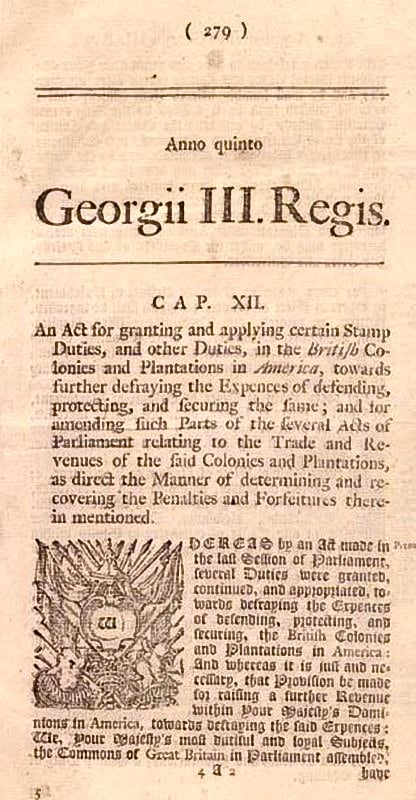
Notice of Stamp Act of 1765 in newspaper
Prime Minister George Grenville asserted in 1762 that the whole revenue of the custom houses in America amounted to one or two thousand pounds a year, and that the English exchequer was paying between seven and eight thousand pounds a year to collect .[21] Adam Smith wrote in The Wealth of Nations that Parliament "has never hitherto demanded of [the American colonies] anything which even approached to a just proportion to what was paid by their fellow subjects at home."[21]
As early as 1651, the English government had sought to regulate trade in the American colonies. On October 9, 1651, they passed the Navigation Acts to pursue a mercantilist policy intended to ensure that trade enriched Great Britain but prohibited trade with any other nations.[22][23] Parliament also passed the Sugar Act, decreasing the existing customs duties on sugar and molasses but providing stricter measures of enforcement and collection. That same year, Grenville proposed direct taxes on the colonies to raise revenue, but he delayed action to see whether the colonies would propose some way to raise the revenue themselves.[24]
Parliament finally passed the Stamp Act in March 1765 which imposed direct taxes on the colonies for the first time. All official documents, newspapers, almanacs, and pamphlets were required to have the stamps—even decks of playing cards. The colonists did not object that the taxes were high; they were actually low.[25] They objected to the fact that they had no representation in the Parliament, and thus no voice concerning legislation that affected them. Benjamin Franklin testified in Parliament in 1766 that Americans already contributed heavily to the defense of the Empire. He said that local governments had raised, outfitted, and paid 25,000 soldiers to fight France—as many as Britain itself sent—and spent many millions from American treasuries doing so in the French and Indian War alone.[26][27] London had to deal with 1,500 politically well-connected British Army soldiers. The decision was to keep them on active duty with full pay, but they had to be stationed somewhere. Stationing a standing army in Great Britain during peacetime was politically unacceptable, so the decision was made to station them in America and have the Americans pay them. The soldiers had no military mission; they were not there to defend the colonies because there was no threat to the colonies.[28]
The Sons of Liberty formed that same year in 1765, and they used public demonstrations, boycott, and threats of violence to ensure that the British tax laws were unenforceable. In Boston, the Sons of Liberty burned the records of the vice admiralty court and looted the home of chief justice Thomas Hutchinson. Several legislatures called for united action, and nine colonies sent delegates to the Stamp Act Congress in New York City in October. Moderates led by John Dickinson drew up a "Declaration of Rights and Grievances" stating that taxes passed without representation violated their rights as Englishmen, and colonists emphasized their determination by boycotting imports of British merchandise.[29]
The Parliament at Westminster saw itself as the supreme lawmaking authority throughout all British possessions and thus entitled to levy any tax without colonial approval.[30] They argued that the colonies were legally British corporations that were completely subordinate to the British parliament, and they pointed to numerous instances where Parliament had made laws in the past that were binding on the colonies.[31] Parliament insisted that the colonies effectively enjoyed a "virtual representation" as most British people did, as only a small minority of the British population elected representatives to Parliament,[32] but Americans such as James Otis maintained that they were not in fact virtually represented at all.[33]
The Rockingham government came to power in July 1765, and Parliament debated whether to repeal the stamp tax or to send an army to enforce it. Benjamin Franklin made the case for repeal, explaining that the colonies had spent heavily in manpower, money, and blood in defense of the empire in a series of wars against the French and Indians, and that further taxes to pay for those wars were unjust and might bring about a rebellion. Parliament agreed and repealed the tax on February 21, 1766, but they insisted in the Declaratory Act of March 1766 that they retained full power to make laws for the colonies "in all cases whatsoever".[34] The repeal nonetheless caused widespread celebrations in the colonies.
1767–1773: Townshend Acts and the Tea Act
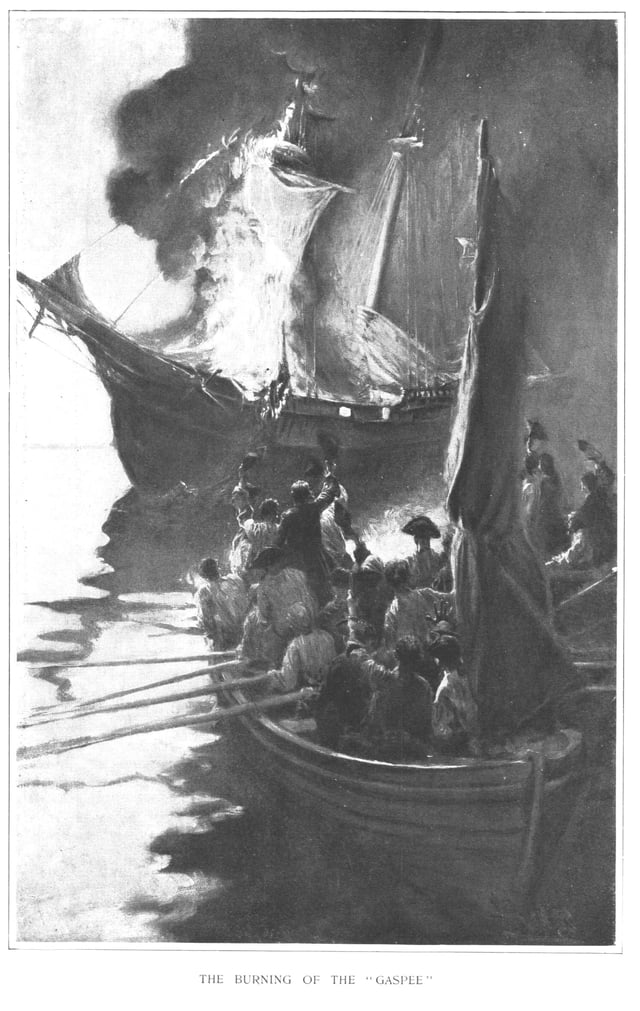
Burning of the Gaspee
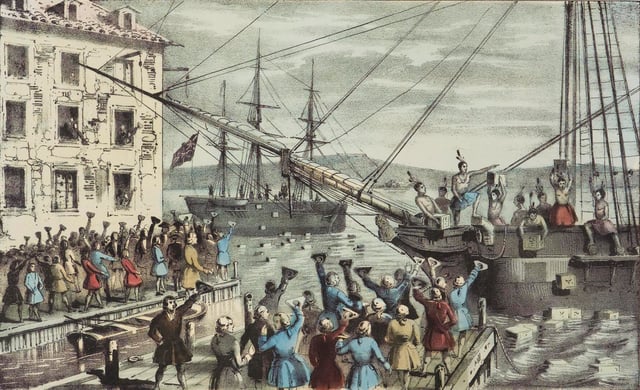
This 1846 lithograph by Nathaniel Currier was entitled The Destruction of Tea at Boston Harbor; the phrase "Boston Tea Party" had not yet become standard.[37]
In 1767, the Parliament passed the Townshend Acts which placed duties on a number of essential goods, including paper, glass, and tea, and established a Board of Customs in Boston to more rigorously execute trade regulations. The new taxes were enacted on the belief that Americans only objected to internal taxes and not to external taxes such as custom duties. The Americans, however, argued against the constitutionality of the act because its purpose was to raise revenue and not regulate trade.[35] Colonists responded by organizing new boycotts of British goods. These boycotts were less effective, however, as the Townshend goods were widely used.
In February 1768, the Assembly of Massachusetts Bay issued a circular letter to the other colonies urging them to coordinate resistance. The governor dissolved the assembly when it refused to rescind the letter. Meanwhile, a riot broke out in Boston in June 1768 over the seizure of the sloop Liberty, owned by John Hancock, for alleged smuggling. Customs officials were forced to flee, prompting the British to deploy troops to Boston. A Boston town meeting declared that no obedience was due to parliamentary laws and called for the convening of a convention. A convention assembled but only issued a mild protest before dissolving itself. In January 1769, Parliament responded to the unrest by reactivating the Treason Act 1543 which called for subjects outside the realm to face trials for treason in England. The governor of Massachusetts was instructed to collect evidence of said treason, and the threat caused widespread outrage, though it was not carried out.
On March 5, 1770, a large crowd gathered around a group of British soldiers. The crowd grew threatening, throwing snowballs, rocks, and debris at them. One soldier was clubbed and fell.[36] There was no order to fire, but the soldiers fired into the crowd anyway. They hit 11 people; three civilians died at the scene of the shooting, and two died after the incident. The event quickly came to be called the Boston Massacre. The soldiers were tried and acquitted (defended by John Adams), but the widespread descriptions soon began to turn colonial sentiment against the British. This, in turn, began a downward spiral in the relationship between Britain and the Province of Massachusetts.[36]
A new ministry under Lord North came to power in 1770, and Parliament withdrew all taxes except the tax on tea, giving up its efforts to raise revenue while maintaining the right to tax. This temporarily resolved the crisis, and the boycott of British goods largely ceased, with only the more radical patriots such as Samuel Adams continuing to agitate.
In June 1772, American patriots, including John Brown, burned a British warship that had been vigorously enforcing unpopular trade regulations in what became known as the Gaspee Affair. The affair was investigated for possible treason, but no action was taken.
In 1772, it became known that the Crown intended to pay fixed salaries to the governors and judges in Massachusetts, which had been paid by local authorities. This would reduce the influence of colonial representatives over their government. Samuel Adams in Boston set about creating new Committees of Correspondence, which linked Patriots in all 13 colonies and eventually provided the framework for a rebel government. Virginia, the largest colony, set up its Committee of Correspondence in early 1773, on which Patrick Henry and Thomas Jefferson served.[38]
A total of about 7000 to 8000 Patriots served on "Committees of Correspondence" at the colonial and local levels, comprising most of the leadership in their communities. Loyalists were excluded. The committees became the leaders of the American resistance to British actions, and largely determined the war effort at the state and local level. When the First Continental Congress decided to boycott British products, the colonial and local Committees took charge, examining merchant records and publishing the names of merchants who attempted to defy the boycott by importing British goods.[39]
In 1773, private letters were published in which Massachusetts Governor Thomas Hutchinson claimed that the colonists could not enjoy all English liberties, and Lieutenant Governor Andrew Oliver called for the direct payment of colonial officials. The letters' contents were used as evidence of a systematic plot against American rights, and discredited Hutchinson in the eyes of the people; the Assembly petitioned for his recall. Benjamin Franklin, postmaster general for the colonies, acknowledged that he leaked the letters, which led to him being berated by British officials and fired from his job.
Meanwhile, Parliament passed the Tea Act to lower the price of taxed tea exported to the colonies in order to help the East India Company undersell smuggled Dutch tea. Special consignees were appointed to sell the tea in order to bypass colonial merchants. The act was opposed by those who resisted the taxes and also by smugglers who stood to lose business. In most instances, the consignees were forced to resign and the tea was turned back, but Massachusetts governor Hutchinson refused to allow Boston merchants to give in to pressure. A town meeting in Boston determined that the tea would not be landed, and ignored a demand from the governor to disperse. On December 16, 1773, a group of men, led by Samuel Adams and dressed to evoke the appearance of American Indians, boarded the ships of the British East India Company and dumped £10,000 worth of tea from their holds (approximately £636,000 in 2008) into Boston Harbor. Decades later, this event became known as the Boston Tea Party and remains a significant part of American patriotic lore.[40]
1774–1775: Intolerable Acts and the Quebec Act
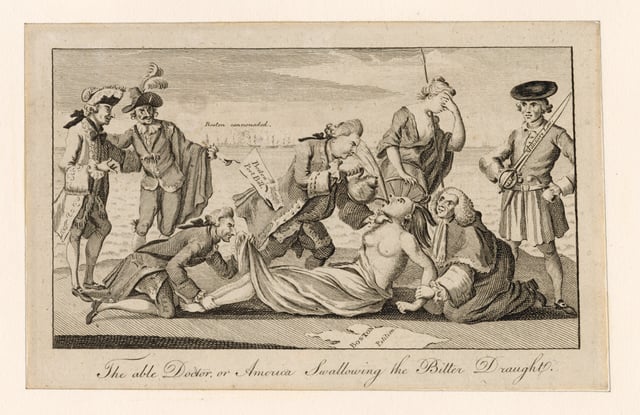
A 1774 etching from The London Magazine, copied by Paul Revere of Boston. Prime Minister Lord North, author of the Boston Port Act, forces the Intolerable Acts down the throat of America, whose arms are restrained by Lord Chief Justice Mansfield, while Lord Sandwich pins down her feet and peers up her robes. Behind them, Mother Britannia weeps helplessly, while France and Spain look on.
The British government responded by passing several Acts which came to be known as the Intolerable Acts, which further darkened colonial opinion towards the British. They consisted of four laws enacted by the British parliament.[41] The first was the Massachusetts Government Act which altered the Massachusetts charter and restricted town meetings. The second act was the Administration of Justice Act which ordered that all British soldiers to be tried were to be arraigned in Britain, not in the colonies. The third Act was the Boston Port Act, which closed the port of Boston until the British had been compensated for the tea lost in the Boston Tea Party. The fourth Act was the Quartering Act of 1774, which allowed royal governors to house British troops in the homes of citizens without requiring permission of the owner.[42]
In response, Massachusetts patriots issued the Suffolk Resolves and formed an alternative shadow government known as the "Provincial Congress" which began training militia outside British-occupied Boston.[43] In September 1774, the First Continental Congress convened, consisting of representatives from each of the colonies, to serve as a vehicle for deliberation and collective action. During secret debates, conservative Joseph Galloway proposed the creation of a colonial Parliament that would be able to approve or disapprove of acts of the British Parliament, but his idea was not accepted. The Congress instead endorsed the proposal of John Adams that Americans would obey Parliament voluntarily but would resist all taxes in disguise. Congress called for a boycott beginning on 1 December 1774 of all British goods; it was enforced by new committees authorized by the Congress.[44]
Military hostilities begin
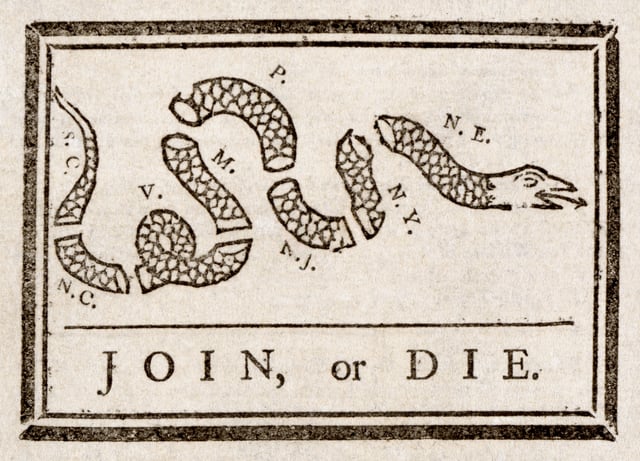
Join, or Die by Benjamin Franklin was recycled to encourage the former colonies to unite against British rule.
Massachusetts was declared in a state of rebellion in February 1775 and the British garrison received orders to disarm the rebels and arrest their leaders, leading to the Battles of Lexington and Concord on 19 April 1775. The Patriots laid siege to Boston, expelled royal officials from all the colonies, and took control through the establishment of Provincial Congresses. The Battle of Bunker Hill followed on June 17, 1775. It was a British victory—but at a great cost: about 1,000 British casualties from a garrison of about 6,000, as compared to 500 American casualties from a much larger force.[45][46] The Second Continental Congress was divided on the best course of action, but eventually produced the Olive Branch Petition, in which they attempted to come to an accord with King George. The king, however, issued a Proclamation of Rebellion which stated that the states were "in rebellion" and the members of Congress were traitors.
The war that arose was in some ways a classic insurgency. As Benjamin Franklin wrote to Joseph Priestley in October 1775: "Britain, at the expense of three millions, has killed 150 Yankees this campaign, which is £20,000 a head... During the same time, 60,000 children have been born in America. From these data his mathematical head will easily calculate the time and expense necessary to kill us all.".[47]
In the winter of 1775, the Americans invaded Canada under generals Benedict Arnold and Richard Montgomery. The attack was a failure; many Americans who weren't killed were either captured or died of smallpox.
In March 1776, the Continental Army forced the British to evacuate Boston, with George Washington as the commander of the new army. The revolutionaries were now in full control of all 13 colonies and were ready to declare independence. There still were many Loyalists, but they were no longer in control anywhere by July 1776, and all of the Royal officials had fled.[48]
Creating new state constitutions
Following the Battle of Bunker Hill in June 1775, the Patriots had control of Massachusetts outside the Boston city limits, and the Loyalists suddenly found themselves on the defensive with no protection from the British army. In all 13 colonies, Patriots had overthrown their existing governments, closing courts and driving away British officials. They had elected conventions and "legislatures" that existed outside any legal framework; new constitutions were drawn up in each state to supersede royal charters. They declared that they were states, not colonies.[49]
On January 5, 1776, New Hampshire ratified the first state constitution. In May 1776, Congress voted to suppress all forms of crown authority, to be replaced by locally created authority. Virginia, South Carolina, and New Jersey created their constitutions before July 4. Rhode Island and Connecticut simply took their existing royal charters and deleted all references to the crown.[50] The new states were all committed to republicanism, with no inherited offices. They decided what form of government to create, and also how to select those who would craft the constitutions and how the resulting document would be ratified. On 26 May 1776, John Adams wrote James Sullivan from Philadelphia:
Depend upon it, sir, it is dangerous to open so fruitful a source of controversy and altercation, as would be opened by attempting to alter the qualifications of voters. There will be no end of it. New claims will arise. Women will demand a vote. Lads from twelve to twenty one will think their rights not enough attended to, and every man, who has not a farthing, will demand an equal voice with any other in all acts of state. It tends to confound and destroy all distinctions, and prostrate all ranks, to one common level[.][51][52]
The resulting constitutions in states such as Maryland, Virginia, Delaware, New York, and Massachusetts[53] featured:
Property qualifications for voting and even more substantial requirements for elected positions (though New York and Maryland lowered property qualifications)[49]
Bicameral legislatures, with the upper house as a check on the lower
Strong governors with veto power over the legislature and substantial appointment authority
Few or no restraints on individuals holding multiple positions in government
The continuation of state-established religion
In Pennsylvania, New Jersey, and New Hampshire, the resulting constitutions embodied:
universal manhood suffrage, or minimal property requirements for voting or holding office (New Jersey enfranchised some property-owning widows, a step that it retracted 25 years later)
strong, unicameral legislatures
relatively weak governors without veto powers, and with little appointing authority
prohibition against individuals holding multiple government posts
The radical provisions of Pennsylvania's constitution lasted only 14 years. In 1790, conservatives gained power in the state legislature, called a new constitutional convention, and rewrote the constitution. The new constitution substantially reduced universal male suffrage, gave the governor veto power and patronage appointment authority, and added an upper house with substantial wealth qualifications to the unicameral legislature. Thomas Paine called it a constitution unworthy of America.[1]
Independence and Union
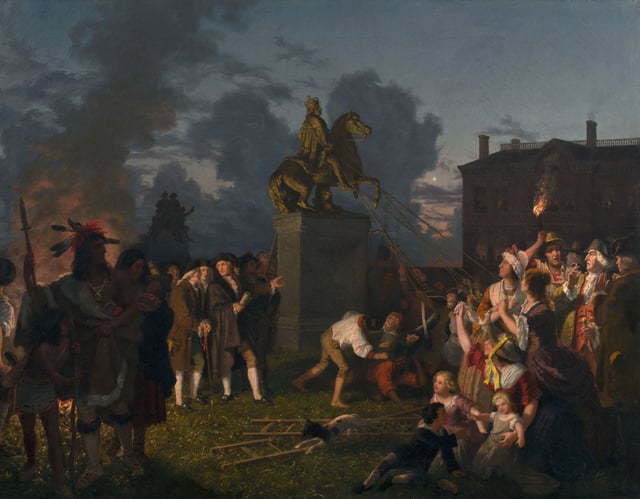
Johannes Adam Simon Oertel, Pulling Down the Statue of King George III, N.Y.C., ca. 1859
In April 1776, the North Carolina Provincial Congress issued the Halifax Resolves explicitly authorizing its delegates to vote for independence.[54] By June, nine Provincial Congresses were ready for independence; one by one, the last four fell into line: Pennsylvania, Delaware, Maryland, and New York. Richard Henry Lee was instructed by the Virginia legislature to propose independence, and he did so on June 7, 1776. On June 11, a committee was created to draft a document explaining the justifications for separation from Britain. After securing enough votes for passage, independence was voted for on July 2.
The Declaration of Independence was drafted largely by Thomas Jefferson and presented by the committee; it was unanimously adopted by the entire Congress on July 4,[55] and each of the colonies became independent and autonomous. The next step was to form a union to facilitate international relations and alliances.[56][57]
The Second Continental Congress approved the "Articles of Confederation" for ratification by the states on November 15, 1777; the Congress immediately began operating under the Articles' terms, providing a structure of shared sovereignty during prosecution of the war and facilitating international relations and alliances with France and Spain. The articles were ratified on March 1, 1781. At that point, the Continental Congress was dissolved and a new government of the United States in Congress Assembled took its place on the following day, with Samuel Huntington as presiding officer.[58][59]
Defending the Revolution
British return: 1776–1777
According to British historian Jeremy Black, the British had significant advantages, including a highly trained army, the world's largest navy, and an efficient system of public finance that could easily fund the war. However, they seriously misunderstood the depth of support for the American Patriot position and ignored the advice of General Gage, misinterpreting the situation as merely a large-scale riot. The British government believed that they could overawe the Americans by sending a large military and naval force, forcing them to be loyal again:
Convinced that the Revolution was the work of a full few miscreants who had rallied an armed rabble to their cause, they expected that the revolutionaries would be intimidated…. Then the vast majority of Americans, who were loyal but cowed by the terroristic tactics… would rise up, kick out the rebels, and restore loyal government in each colony.[60]
Washington forced the British out of Boston in the spring of 1776, and neither the British nor the Loyalists controlled any significant areas. The British, however, were massing forces at their naval base at Halifax, Nova Scotia. They returned in force in July 1776, landing in New York and defeating Washington's Continental Army in August at the Battle of Brooklyn. Following that victory, they requested a meeting with representatives from Congress to negotiate an end to hostilities.[61][62]
A delegation including John Adams and Benjamin Franklin met British admiral Richard Howe on Staten Island in New York Harbor on September 11 in what became known as the Staten Island Peace Conference. Howe demanded that the Americans retract the Declaration of Independence, which they refused to do, and negotiations ended. The British then seized New York City and nearly captured Washington's army. They made New York their main political and military base of operations, holding it until November 1783. The city became the destination for Loyalist refugees and a focal point of Washington's intelligence network.[61][62]
The British also took New Jersey, pushing the Continental Army into Pennsylvania. Washington crossed the Delaware River back into New Jersey in a surprise attack in late December 1776 and defeated the Hessian and British armies at Trenton and Princeton, thereby regaining control of most of New Jersey. The victories gave an important boost to Patriots at a time when morale was flagging, and they have become iconic events of the war.
In 1777, the British sent Burgoyne's invasion force from Canada south to New York to seal off New England. Their aim was to isolate New England, which the British perceived as the primary source of agitation. Rather than move north to support Burgoyne, the British army in New York City went to Philadelphia in a major case of mis-coordination, capturing it from Washington. The invasion army under Burgoyne was much too slow and became trapped in northern New York state. It surrendered after the Battles of Saratoga in October 1777. From early October 1777 until November 15, a siege distracted British troops at Fort Mifflin, Philadelphia, Pennsylvania and allowed Washington time to preserve the Continental Army by safely leading his troops to harsh winter quarters at Valley Forge.
Prisoners
In August 1775, George III declared Americans to be traitors to the Crown if they took up arms against royal authority. There were thousands of British and Hessian soldiers in American hands following their surrender at the Battles of Saratoga in October 1777. Lord Germain took a hard line, but the British generals on American soil never held treason trials and treated captured American soldiers as prisoners of war.[63] The dilemma was that tens of thousands of Loyalists were under American control and American retaliation would have been easy. The British built much of their strategy around using these Loyalists.[64] The British maltreated the prisoners whom they held, resulting in more deaths to American prisoners of war than from combat operations.[64] At the end of the war, both sides released their surviving prisoners.[65]
American alliances after 1778
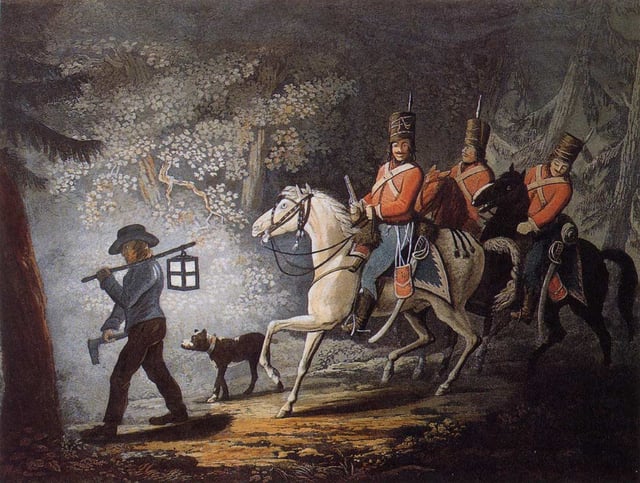
Hessian troops hired out to the British by their German sovereigns
The capture of a British army at Saratoga encouraged the French to formally enter the war in support of Congress, and Benjamin Franklin negotiated a permanent military alliance in early 1778; France thus became the first foreign nation to officially recognize the Declaration of Independence. On February 6, 1778, the United States and France signed the Treaty of Amity and Commerce and the Treaty of Alliance.[66] William Pitt spoke out in Parliament urging Britain to make peace in America and to unite with America against France, while British politicians who had sympathized with colonial grievances now turned against the Americans for allying with Britain's rival and enemy.[67]
The Spanish and the Dutch became allies of the French in 1779 and 1780 respectively, forcing the British to fight a global war without major allies and requiring it to slip through a combined blockade of the Atlantic. Britain began to view the American war for independence as merely one front in a wider war,[68] and the British chose to withdraw troops from America to reinforce the sugar-producing Caribbean colonies, which were more lucrative to British investors. British commander Sir Henry Clinton evacuated Philadelphia and returned to New York City. General Washington intercepted him in the Battle of Monmouth Court House, the last major battle fought in the north. After an inconclusive engagement, the British retreated to New York City. The northern war subsequently became a stalemate, as the focus of attention shifted to the smaller southern theater.[69]
The British move South, 1778–1783
The British strategy in America now concentrated on a campaign in the southern states. With fewer regular troops at their disposal, the British commanders saw the "southern strategy" as a more viable plan, as they perceived the south as strongly Loyalist with a large population of recent immigrants and large numbers of slaves who might be captured or run away to join the British.[70]
Beginning in late December 1778, they captured Savannah and controlled the Georgia coastline. In 1780, they launched a fresh invasion and took Charleston, as well. A significant victory at the Battle of Camden meant that royal forces soon controlled most of Georgia and South Carolina. The British set up a network of forts inland, hoping that the Loyalists would rally to the flag.[71] Not enough Loyalists turned out, however, and the British had to fight their way north into North Carolina and Virginia with a severely weakened army. Behind them, much of the territory that they had already captured dissolved into a chaotic guerrilla war, fought predominantly between bands of Loyalists and American militia, which negated many of the gains that the British had previously made.[71]
Surrender at Yorktown (1781)
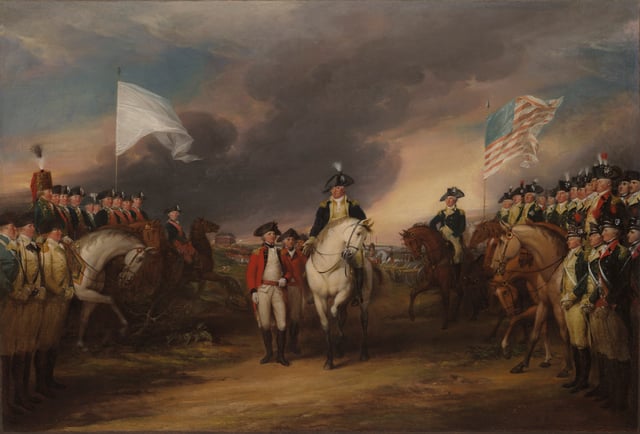
Surrender of Lord Cornwallis by John TrumbullThe siege of Yorktown ended with the surrender of a second British army, marking effective British defeat.
The British army under Cornwallis marched to Yorktown, Virginia where they expected to be rescued by a British fleet.[72] The fleet did arrive, but so did a larger French fleet. The French were victorious in the Battle of the Chesapeake, and the British fleet returned to New York for reinforcements, leaving Cornwallis trapped. In October 1781, the British surrendered their second invading army of the war, under a siege by the combined French and Continental armies commanded by Washington.[73]
The end of the war
Historians continue to debate whether the odds were long or short for American victory. John E. Ferling says that the odds were so long that the American victory was "almost a miracle".[74] On the other hand, Joseph Ellis says that the odds favored the Americans, and asks whether there ever was any realistic chance for the British to win. He argues that this opportunity came only once, in the summer of 1776, and the British failed that test. Admiral Howe and his brother General Howe "missed several opportunities to destroy the Continental Army…. Chance, luck, and even the vagaries of the weather played crucial roles." Ellis's point is that the strategic and tactical decisions of the Howes were fatally flawed because they underestimated the challenges posed by the Patriots. Ellis concludes that, once the Howe brothers failed, the opportunity "would never come again" for a British victory.[75]
Support for the conflict had never been strong in Britain, where many sympathized with the Americans, but now it reached a new low.[76] King George personally wanted to fight on, but his supporters lost control of Parliament and they launched no further offensives in America.[69][77] War erupted between America and Britain three decades later with the War of 1812, which firmly established the permanence of the United States and its complete autonomy.[78]
Washington did not know whether the British might reopen hostilities after Yorktown. They still had 26,000 troops occupying New York City, Charleston, and Savannah, together with a powerful fleet. The French army and navy departed, so the Americans were on their own in 1782–83.[79] The treasury was empty, and the unpaid soldiers were growing restive, almost to the point of mutiny or possible coup d'état. Washington personally dispelled the unrest among officers of the Newburgh Conspiracy in 1783, and Congress subsequently created the promise of a five years bonus for all officers.[80]
Paris peace treaty
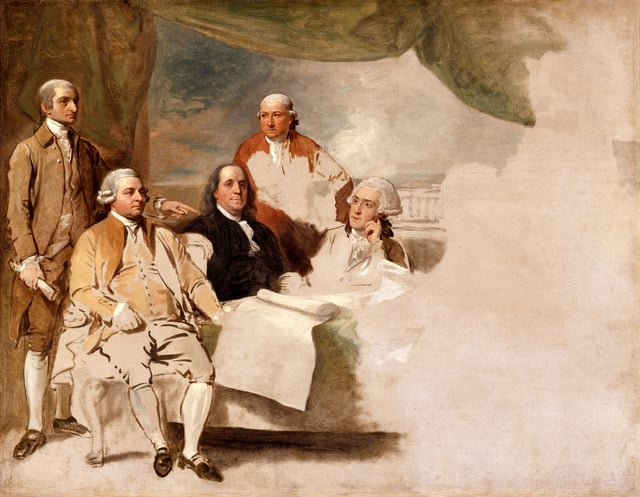
The United States delegation at the 1783 Treaty of Paris included John Jay, John Adams, Benjamin Franklin, Henry Laurens, and William Temple Franklin. Here they are depicted by Benjamin West in his American Commissioners of the Preliminary Peace Agreement with Great Britain. The British delegation refused to pose and the painting was never completed.
During negotiations in Paris, the American delegation discovered that France supported American independence but no territorial gains, hoping to confine the new nation to the area east of the Appalachian Mountains. The Americans opened direct secret negotiations with London, cutting out the French. British Prime Minister Lord Shelburne was in full charge of the British negotiations, and he saw a chance to make the United States a valuable economic partner.[81] The US obtained all the land east of the Mississippi River, south of Canada, and north of Florida. It gained fishing rights off Canadian coasts, and agreed to allow British merchants and Loyalists to recover their property. Prime Minister Shelburne foresaw highly profitable two-way trade between Britain and the rapidly growing United States, which did come to pass. The blockade was lifted and all British interference had been driven out, and American merchants were free to trade with any nation anywhere in the world.[82]
The British largely abandoned their American Indian allies, who were not a party to this treaty and did not recognize it until they were defeated militarily by the United States. However, the British did sell them munitions and maintain forts in American territory until the Jay Treaty of 1795.[83]
Losing the war and the Thirteen Colonies was a shock to Britain. The war revealed the limitations of Britain's fiscal-military state when they discovered that they suddenly faced powerful enemies with no allies, and they were dependent on extended and vulnerable transatlantic lines of communication. The defeat heightened dissension and escalated political antagonism to the King's ministers. Inside Parliament, the primary concern changed from fears of an over-mighty monarch to the issues of representation, parliamentary reform, and government retrenchment. Reformers sought to destroy what they saw as widespread institutional corruption,[84][85] and the result was a crisis from 1776 to 1783. The peace in 1783 left France financially prostrate, while the British economy boomed thanks to the return of American business. The crisis ended after 1784 thanks to the King's shrewdness in outwitting Charles James Fox (the leader of the Fox-North Coalition), and renewed confidence in the system engendered by the leadership of Prime Minister William Pitt. Some historians suggest that loss of the American colonies enabled Britain to deal with the French Revolution with more unity and better organization than would otherwise have been the case.[84][85] Britain turned towards Asia, the Pacific, and later Africa with subsequent exploration leading to the rise of the Second British Empire.[86]
Finance
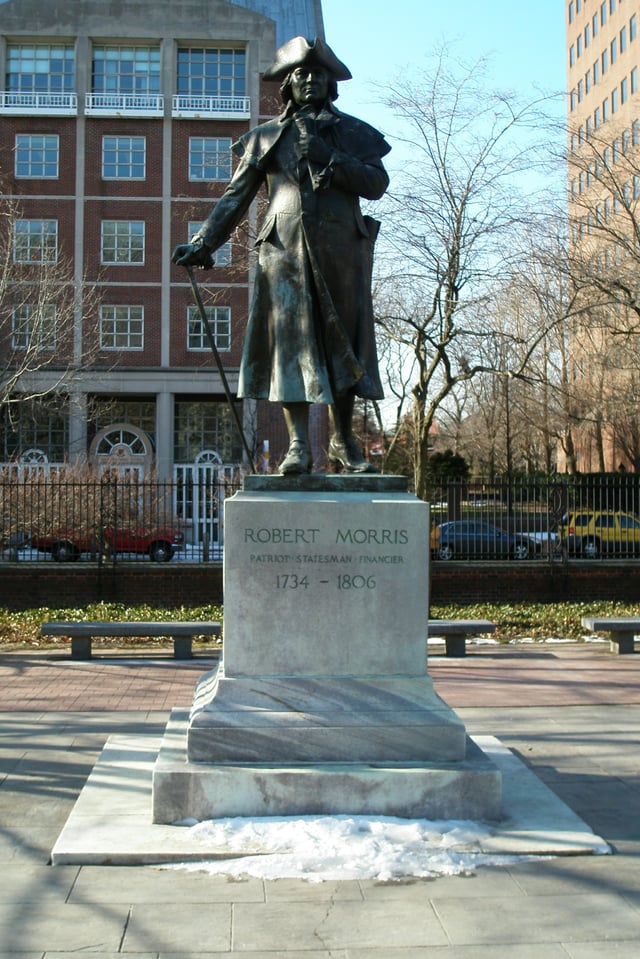
Robert Morris, Independence National Historical Park
Britain's war against the Americans, the French, and the Spanish cost about £100 million, and the Treasury borrowed 40-percent of the money that it needed.[87] Heavy spending brought France to the verge of bankruptcy and revolution, while the British had relatively little difficulty financing their war, keeping their suppliers and soldiers paid, and hiring tens of thousands of German soldiers.[88] Britain had a sophisticated financial system based on the wealth of thousands of landowners who supported the government, together with banks and financiers in London. The British tax system collected about 12 percent of the GDP in taxes during the 1770s.[88]
In sharp contrast, Congress and the American states had no end of difficulty financing the war.[89] In 1775, there was at most 12 million dollars in gold in the colonies, not nearly enough to cover current transactions, let alone finance a major war. The British made the situation much worse by imposing a tight blockade on every American port, which cut off almost all imports and exports. One partial solution was to rely on volunteer support from militiamen and donations from patriotic citizens.[90][91] Another was to delay actual payments, pay soldiers and suppliers in depreciated currency, and promise that it would be made good after the war. Indeed, the soldiers and officers were given land grants in 1783 to cover the wages that they had earned but had not been paid during the war. The national government did not have a strong leader in financial matters until 1781, when Robert Morris was named Superintendent of Finance of the United States.[90] Morris used a French loan in 1782 to set up the private Bank of North America to finance the war. He reduced the civil list, saved money by using competitive bidding for contracts, tightened accounting procedures, and demanded the national government's full share of money and supplies from the individual states.[90]
Congress used four main methods to cover the cost of the war, which cost about 66 million dollars in specie (gold and silver).[92] Congress made issues of paper money in 1775–1780 and in 1780–81. The first issue amounted to 242 million dollars. This paper money would supposedly be redeemed for state taxes, but the holders were eventually paid off in 1791 at the rate of one cent on the dollar. By 1780, the paper money was "not worth a Continental", as people said.[93] The skyrocketing inflation was a hardship on the few people who had fixed incomes, but 90 percent of the people were farmers and were not directly affected by it. Debtors benefited by paying off their debts with depreciated paper. The greatest burden was borne by the soldiers of the Continental Army whose wages were usually in arrears and declined in value every month, weakening their morale and adding to the hardships of their families.[94]
Beginning in 1777, Congress repeatedly asked the states to provide money, but the states had no system of taxation and were of little help. By 1780, Congress was making requisitions for specific supplies of corn, beef, pork, and other necessities, an inefficient system which barely kept the army alive.[95][96] Starting in 1776, the Congress sought to raise money by loans from wealthy individuals, promising to redeem the bonds after the war. The bonds were in fact redeemed in 1791 at face value, but the scheme raised little money because Americans had little specie, and many of the rich merchants were supporters of the Crown. The French secretly supplied the Americans with money, gunpowder, and munitions in order to weaken Great Britain; the subsidies continued when France entered the war in 1778, and the French government and Paris bankers lent large sums to the American war effort. These loans were repaid in full in the 1790s.[97]
Concluding the Revolution
Creating a "more perfect union" and guaranteeing rights
The war ended in 1783 and was followed by a period of prosperity. The national government was still operating under the Articles of Confederation and was able to settle the issue of the western territories, which the states ceded to Congress. American settlers moved rapidly into those areas, with Vermont, Kentucky, and Tennessee becoming states in the 1790s.[98]
However, the national government had no money either to pay the war debts owed to European nations and the private banks, or to pay Americans who had been given millions of dollars of promissory notes for supplies during the war. Nationalists led by Washington, Alexander Hamilton, and other veterans feared that the new nation was too fragile to withstand an international war, or even internal revolts such as the Shays' Rebellion of 1786 in Massachusetts. They convinced Congress to call the Philadelphia Convention in 1787 and named their party the Federalist party.[99] The Convention adopted a new Constitution which provided for a much stronger federal government, including an effective executive in a check-and-balance system with the judiciary and legislature.[100] The Constitution was ratified in 1788, after a fierce debate in the states over the nature of the proposed new government. The new government under President George Washington took office in New York in March 1789.[101] James Madison spearheaded Congressional amendments to the Constitution as assurances to those who were cautious about federal power, guaranteeing many of the inalienable rights that formed a foundation for the revolution, and Rhode Island was the final state to ratify the Constitution in 1791.
National debt
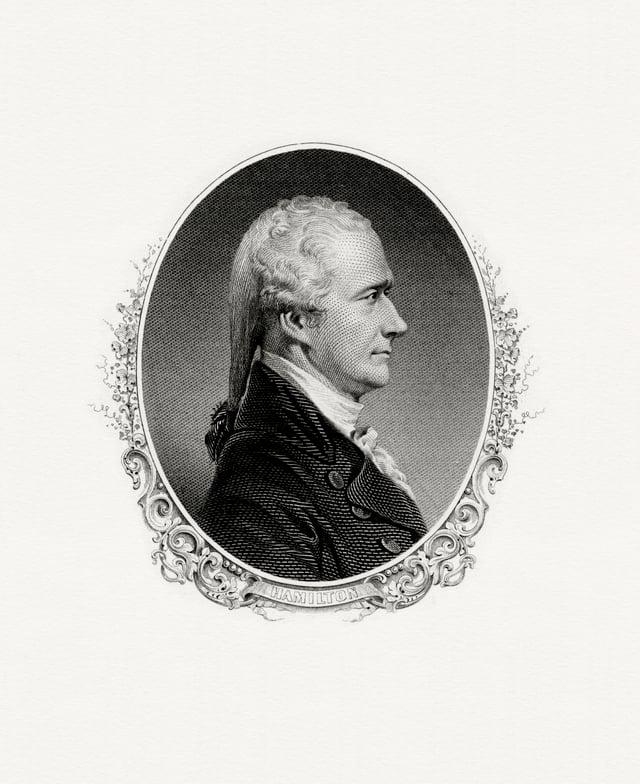
A Bureau of Engraving and Printing portrait of Hamilton as Secretary of the Treasury
The national debt fell into three categories after the American Revolution. The first was the $12 million owed to foreigners, mostly money borrowed from France. There was general agreement to pay the foreign debts at full value. The national government owed $40 million and state governments owed $25 million to Americans who had sold food, horses, and supplies to the Patriot forces. There were also other debts which consisted of promissory notes issued during the war to soldiers, merchants, and farmers who accepted these payments on the premise that the new Constitution would create a government that would pay these debts eventually.
The war expenses of the individual states added up to $114 million, compared to $37 million by the central government.[102] In 1790, Congress combined the remaining state debts with the foreign and domestic debts into one national debt totaling $80 million at the recommendation of first Secretary of the Treasury Alexander Hamilton. Everyone received face value for wartime certificates, so that the national honor would be sustained and the national credit established.[103]
Ideology and factions
The population of the Thirteen States was not homogeneous in political views and attitudes. Loyalties and allegiances varied widely within regions and communities and even within families, and sometimes shifted during the course of the Revolution.
Ideology behind the Revolution
The American Enlightenment was a critical precursor of the American Revolution. Chief among the ideas of the American Enlightenment were the concepts of Natural Law, Natural Rights, Consent of the Governed, Individualism, Property Rights, Self-Ownership, Self-Determination, liberalism, republicanism, and defense against corruption. A growing number of American colonists embraced these views and fostered an intellectual environment which led to a new sense of political and social identity.[104]
Liberalism
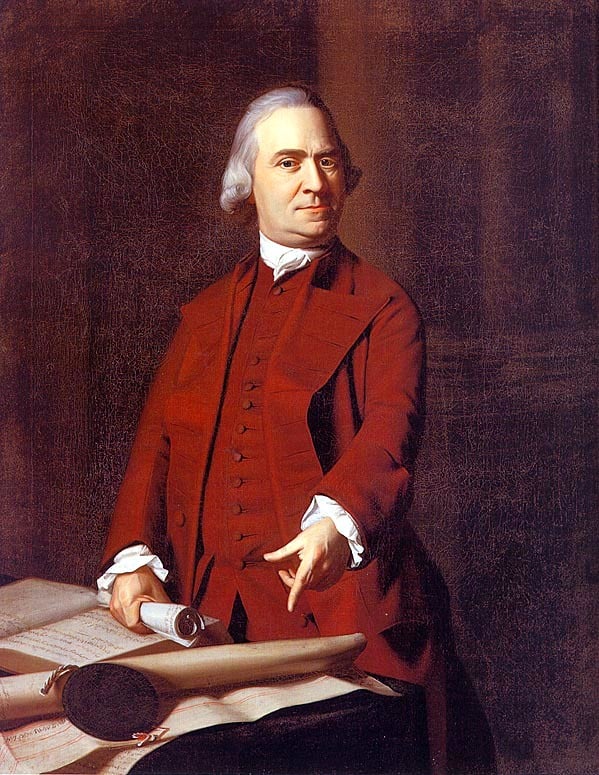
In this c. 1772 portrait by John Singleton Copley, Samuel Adams points at the Massachusetts Charter which he viewed as a constitution that protected the people's rights.[105]
John Locke's (1632–1704) ideas on liberty influenced the political thinking behind the revolution, especially through his indirect influence on English writers such as John Trenchard, Thomas Gordon, and Benjamin Hoadly, whose political ideas in turn had a strong influence on the American Patriots.[106] Locke is often referred to as "the philosopher of the American Revolution" due to his work in the Social Contract and Natural Rights theories that underpinned the Revolution's political ideology.[107] Locke's Two Treatises of Government published in 1689 was especially influential. He argued that all humans were created equally free, and governments therefore needed the "consent of the governed".[108] In late eighteenth-century America, belief was still widespread in "equality by creation" and "rights by creation".[109]
The theory of the "social contract" influenced the belief among many of the Founders that the right of the people to overthrow their leaders was one of the "natural rights" of man, should those leaders betray the historic rights of Englishmen.[110][111] The Americans heavily used Montesquieu's analysis of the wisdom of the "balanced" British Constitution (mixed government) in writing the state and national constitutions.
Republicanism
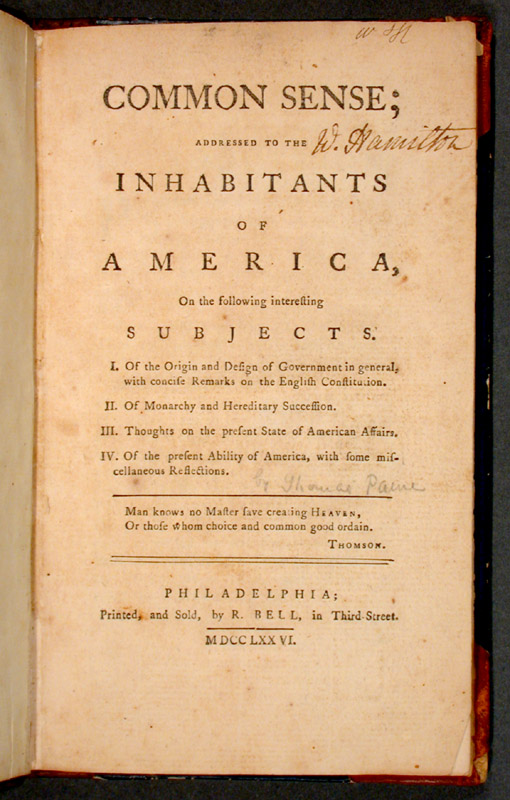
Thomas Paine's pamphlet Common Sense, published in 1776
The American ideology called "republicanism" was inspired by the Whig party in Great Britain which openly criticized the corruption within the British government.[112] Americans were increasingly embracing republican values, seeing Britain as corrupt and hostile to American interests.[113] The colonists associated political corruption with luxury and inherited aristocracy, which they condemned.[114]
The Founding Fathers were strong advocates of republican values, particularly Samuel Adams, Patrick Henry, John Adams, Benjamin Franklin, Thomas Jefferson, Thomas Paine, George Washington, James Madison, and Alexander Hamilton,[115] which required men to put civic duty ahead of their personal desires. Men had a civic duty to be prepared and willing to fight for the rights and liberties of their countrymen. John Adams wrote to Mercy Otis Warren in 1776, agreeing with some classical Greek and Roman thinkers: "Public Virtue cannot exist without private, and public Virtue is the only Foundation of Republics." He continued:
There must be a positive Passion for the public good, the public Interest, Honour, Power, and Glory, established in the Minds of the People, or there can be no Republican Government, nor any real Liberty. And this public Passion must be Superior to all private Passions. Men must be ready, they must pride themselves, and be happy to sacrifice their private Pleasures, Passions, and Interests, nay their private Friendships and dearest connections, when they Stand in Competition with the Rights of society.[116]
"Republican motherhood" became the ideal for American women, exemplified by Abigail Adams and Mercy Otis Warren; the first duty of the republican woman was to instill republican values in her children and to avoid luxury and ostentation.[117]
Thomas Paine published his pamphlet Common Sense in January 1776, after the Revolution had started. It was widely distributed and often read aloud in taverns, contributing significantly to spreading the ideas of republicanism and liberalism together, bolstering enthusiasm for separation from Great Britain and encouraging recruitment for the Continental Army.[118] Paine offered a solution for Americans who were alarmed by the threat of tyranny.[118]
Protestant Dissenters and the Great Awakening
Protestant churches that had separated from the Church of England (called "dissenters") were the "school of democracy", in the words of historian Patricia Bonomi.[119] Before the Revolution, the Southern Colonies and three of the New England Colonies had officially established churches: Congregational in Massachusetts Bay, Connecticut, and New Hampshire, and Anglican in Maryland, Virginia, North-Carolina, South Carolina, and Georgia. New York, New Jersey, Pennsylvania, Delaware, and the Colony of Rhode Island and Providence Plantations had no officially established churches.[120] Church membership statistics from the period are unreliable and scarce,[121] but what little data exists indicates that Anglicans were not in the majority, not even in the colonies where the Church of England was the established church, and they probably did not comprise even 30 percent of the population (with the possible exception of Virginia).[120]
President John Witherspoon of the College of New Jersey (now Princeton University) wrote widely circulated sermons linking the American Revolution to the teachings of the Bible. Throughout the colonies, dissenting Protestant ministers (Congregational, Baptist, and Presbyterian) preached Revolutionary themes in their sermons, while most Church of England clergymen preached loyalty to the king, the titular head of the English state church.[122] Religious motivation for fighting tyranny transcended socioeconomic lines to encompass rich and poor, men and women, frontiersmen and townsmen, farmers and merchants.[119] The Declaration of Independence also referred to the "Laws of Nature and of Nature's God" as justification for the Americans' separation from the British monarchy. Most eighteenth-century Americans believed that the entire universe ("nature") was God's creation[123] and he was "Nature's God". Everything was part of the "universal order of things" which began with God and was directed by his providence.[124] Accordingly, the signers of the Declaration professed their "firm reliance on the Protection of divine Providence", and they appealed to "the Supreme Judge for the rectitude of our intentions".[125] George Washington was firmly convinced that he was an instrument of providence, to the benefit of the American people and of all humanity.[126]
Historian Bernard Bailyn argues that the evangelicalism of the era challenged traditional notions of natural hierarchy by preaching that the Bible teaches that all men are equal, so that the true value of a man lies in his moral behavior, not in his class.[127] Kidd argues that religious disestablishment, belief in God as the source of human rights, and shared convictions about sin, virtue, and divine providence worked together to unite rationalists and evangelicals and thus encouraged a large proportion of Americans to fight for independence from the Empire. Bailyn, on the other hand, denies that religion played such a critical role.[128] Alan Heimert argues that New Light anti-authoritarianism was essential to furthering democracy in colonial American society, and set the stage for a confrontation with British monarchical and aristocratic rule.[129]
Class and psychology of the factions
John Adams concluded in 1818:
The Revolution was effected before the war commenced. The Revolution was in the minds and hearts of the people…. This radical change in the principles, opinions, sentiments, and affections of the people was the real American Revolution.[130]
In the mid-20th century, historian Leonard Woods Labaree identified eight characteristics of the Loyalists that made them essentially conservative, opposite to the characteristics of the Patriots.[131] Loyalists tended to feel that resistance to the Crown was morally wrong, while the Patriots thought that morality was on their side.[132][133] Loyalists were alienated when the Patriots resorted to violence, such as burning houses and tarring and feathering. Loyalists wanted to take a centrist position and resisted the Patriots' demand to declare their opposition to the Crown. Many Loyalists had maintained strong and long-standing relations with Britain, especially merchants in port cities such as New York and Boston.[132][133] Many Loyalists felt that independence was bound to come eventually, but they were fearful that revolution might lead to anarchy, tyranny, or mob rule. In contrast, the prevailing attitude among Patriots was a desire to seize the initiative.[132][133] Labaree also wrote that Loyalists were pessimists who lacked the confidence in the future displayed by the Patriots.[131]
Historians in the early 20th century such as J. Franklin Jameson examined the class composition of the Patriot cause, looking for evidence of a class war inside the revolution.[134] More recent historians have largely abandoned that interpretation, emphasizing instead the high level of ideological unity.[135] Both Loyalists and Patriots were a "mixed lot",[136][137] but ideological demands always came first. The Patriots viewed independence as a means to gain freedom from British oppression and taxation and to reassert their basic rights. Most yeomen farmers, craftsmen, and small merchants joined the Patriot cause to demand more political equality. They were especially successful in Pennsylvania but less so in New England, where John Adams attacked Thomas Paine's Common Sense for the "absurd democratical notions" that it proposed.[136][137]
King George III
The war became a personal issue for the king, fueled by his growing belief that British leniency would be taken as weakness by the Americans. He also sincerely believed that he was defending Britain's constitution against usurpers, rather than opposing patriots fighting for their natural rights.[138]
Patriots
Those who fought for independence were called "Patriots", "Whigs", "Congress-men", or "Americans" during and after the war. They included a full range of social and economic classes but were unanimous regarding the need to defend the rights of Americans and uphold the principles of republicanism in terms of rejecting monarchy and aristocracy, while emphasizing civic virtue on the part of the citizens. Newspapers were strongholds of patriotism (although there were a few Loyalist papers) and printed many pamphlets, announcements, patriotic letters, and pronouncements.[139]
According to historian Robert Calhoon, 40– to 45-percent of the white population in the Thirteen Colonies supported the Patriots' cause, 15– to 20-percent supported the Loyalists, and the remainder were neutral or kept a low profile.[140] Mark Lender analyzes why ordinary people became insurgents against the British, even if they were unfamiliar with the ideological reasons behind the war. He concludes that such people held a sense of rights which the British were violating, rights that stressed local autonomy, fair dealing, and government by consent. They were highly sensitive to the issue of tyranny, which they saw manifested in the British response to the Boston Tea Party. The arrival in Boston of the British Army heightened their sense of violated rights, leading to rage and demands for revenge. They had faith that God was on their side.[141] The signers of the Declaration of Independence were mostly well-educated, of British stock, and of the Protestant faith.[142][143]
Loyalists
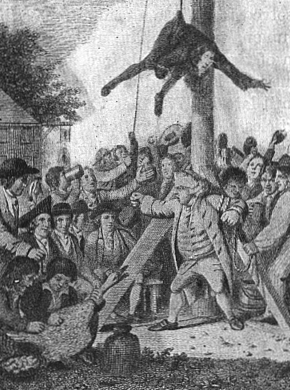
American Patriots mobbing a Loyalist in 1775–76
The consensus of scholars is that about 15– to 20-percent of the white population remained loyal to the British Crown.[144] Those who actively supported the king were known at the time as "Loyalists", "Tories", or "King's men". The Loyalists never controlled territory unless the British Army occupied it. They were typically older, less willing to break with old loyalties, and often connected to the Church of England; they included many established merchants with strong business connections throughout the Empire, as well as royal officials such as Thomas Hutchinson of Boston.[145] There were 500 to 1,000 black loyalists, slaves who escaped to British lines and joined the British army. Most died of disease, but Britain took the survivors to Canada as free men.
The revolution could divide families, such as William Franklin, son of Benjamin Franklin and royal governor of the Province of New Jersey who remained loyal to the Crown throughout the war. He and his father never spoke again.[146] Recent immigrants who had not been fully Americanized were also inclined to support the King, such as Flora MacDonald who was a Scottish settler in the back country.[147]
After the war, the great majority of the approximately 500,000 Loyalists remained in America and resumed normal lives. Some became prominent American leaders, such as Samuel Seabury. Approximately 46,000 Loyalists relocated to Canada; others moved to Britain (7,000), Florida, or the West Indies (9,000). The exiles represented approximately two percent of the total population of the colonies.[148] Nearly all black loyalists left for Nova Scotia, Florida, or England, where they could remain free.[149] Loyalists who left the South in 1783 took thousands of their slaves with them to be slaves in the British West Indies.[148]
Neutrals
A minority of uncertain size tried to stay neutral in the war. Most kept a low profile, but the Quakers were the most important group to speak out for neutrality, especially in Pennsylvania. The Quakers continued to do business with the British even after the war began, and they were accused of being supporters of British rule, "contrivers and authors of seditious publications" critical of the revolutionary cause.[150] The majority of Quakers attempted to remain neutral, although a sizeable number nevertheless participated to some degree.
Role of women
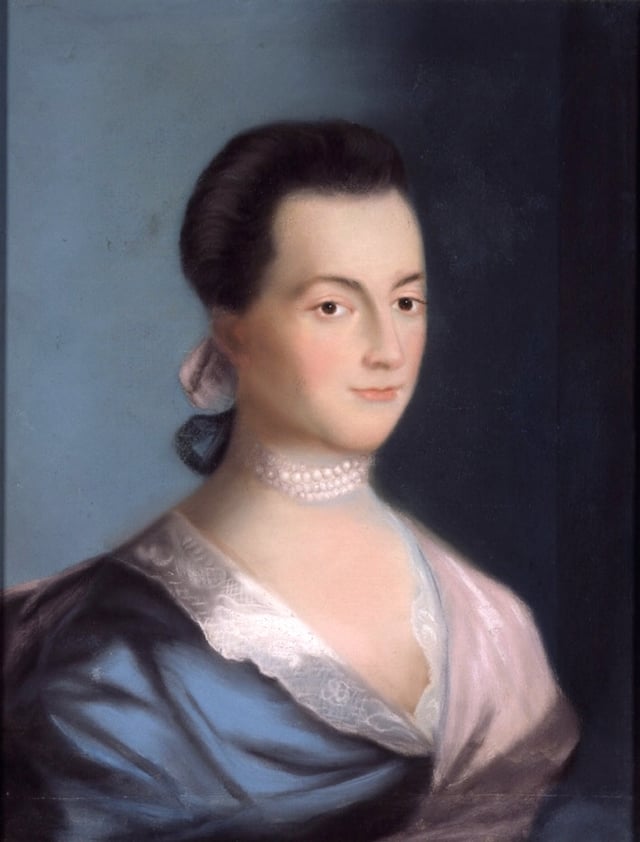
Abigail Adams
Women contributed to the American Revolution in many ways and were involved on both sides. Formal politics did not include women, but ordinary domestic behaviors became charged with political significance as Patriot women confronted a war which permeated all aspects of political, civil, and domestic life. They participated by boycotting British goods, spying on the British, following armies as they marched, washing, cooking, and tending for soldiers, delivering secret messages, and even fighting disguised as men in a few cases, such as Deborah Samson. Mercy Otis Warren held meetings in her house and cleverly attacked Loyalists with her creative plays and histories.[151] Above all, women continued the agricultural work at home to feed their families and the armies. They maintained their families during their husbands' absences and sometimes after their deaths.[152]
American women were integral to the success of the boycott of British goods,[153] as the boycotted items were largely household items such as tea and cloth. Women had to return to knitting goods, and to spinning and weaving their own cloth—skills that had fallen into disuse. In 1769, the women of Boston produced 40,000 skeins of yarn, and 180 women in Middletown, Massachusetts wove 20,522 yards (18,765 m) of cloth.[152] A woman's loyalty to her husband could become an open political act, especially for women in America committed to men who remained loyal to the King. Legal divorce, usually rare, was granted to Patriot women whose husbands supported the King.[154][155]
Other participants
France and Spain
In early 1776, France set up a major program of aid to the Americans, and the Spanish secretly added funds. Each country spent one million "livres tournaises" to buy munitions. A dummy corporation run by Pierre Beaumarchais concealed their activities. American Patriots obtained some munitions through the Dutch Republic, as well as French and Spanish ports in the West Indies.[156]
Spain did not officially recognize the U.S. but it separately declared war on Britain on June 21, 1779. Bernardo de Gálvez y Madrid, general of the Spanish forces in New Spain, also served as governor of Louisiana. He led an expedition of colonial troops to force the British out of Florida and to keep open a vital conduit for supplies.[157]
American Indians
Most American Indians rejected pleas that they remain neutral and instead supported the British Crown. The great majority of the 200,000 Indians east of the Mississippi distrusted the Colonists and supported the British cause, hoping to forestall continued colonial expansion into their territories.[158] Those tribes that were more closely involved in trade tended to side with the Patriots, although political factors were important, as well.
Most Indians did not participate directly in the war, except for warriors and bands associated with four of the Iroquois tribes in New York and Pennsylvania which allied with the British. The British did have other allies, especially in the upper Midwest. They provided Indians with funding and weapons to attack American outposts. Some Indians tried to remain neutral, seeing little value in joining what they perceived to be a European conflict, and fearing reprisals from whichever side they opposed. The Oneida and Tuscarora tribes among the Iroquois of central and western New York supported the American cause.[159] The British provided arms to Indians who were led by Loyalists in war parties to raid frontier settlements from the Carolinas to New York. They killed many settlers on the frontier, especially in Pennsylvania and New York's Mohawk Valley.[160]
In 1776, Cherokee war parties attacked American Colonists all along the southern frontier of the uplands throughout the Washington District, North Carolina (now Tennessee) and the Kentucky wilderness area.[161] They would launch raids with roughly 200 warriors, as seen in the Cherokee–American wars; they could not mobilize enough forces to invade Colonial areas without the help of allies, most often the Creek. The Chickamauga Cherokee under Dragging Canoe allied themselves closely with the British, and fought on for an additional decade after the Treaty of Paris was signed. Joseph Brant of the powerful Mohawk tribe in New York was the most prominent Indian leader against the Patriot forces. In 1778 and 1780, he led 300 Iroquois warriors and 100 white Loyalists in multiple attacks on small frontier settlements in New York and Pennsylvania, killing many settlers and destroying villages, crops, and stores.[162] The Seneca, Onondaga, and Cayuga of the Iroquois Confederacy also allied with the British against the Americans.[163]
In 1779, the Americans forced the hostile Indians out of upstate New York when Washington sent an army under John Sullivan which destroyed 40 empty Iroquois villages in central and western New York. The Battle of Newtown proved decisive, as the Patriots had an advantage of three-to-one, and it ended significant resistance; there was little combat otherwise. Sullivan systematically burned the empty villages and destroyed about 160,000 bushels of corn that composed the winter food supply. Facing starvation and homeless for the winter, the Iroquois fled to Canada. The British resettled them in Ontario, providing land grants as compensation for some of their losses.[164]
At the peace conference following the war, the British ceded lands which they did not really control, and they did not consult their Indian allies. They transferred control to the United States of all the land east of the Mississippi and north of Florida. Calloway concludes:
Burned villages and crops, murdered chiefs, divided councils and civil wars, migrations, towns and forts choked with refugees, economic disruption, breaking of ancient traditions, losses in battle and to disease and hunger, betrayal to their enemies, all made the American Revolution one of the darkest periods in American Indian history.[165]
The British did not give up their forts until 1796 in the eastern Midwest, stretching from Ohio to Wisconsin; they kept alive the dream of forming a satellite Indian nation there, which they called a Neutral Indian Zone. That goal was one of the causes of the War of 1812.[166][167]
Black Americans
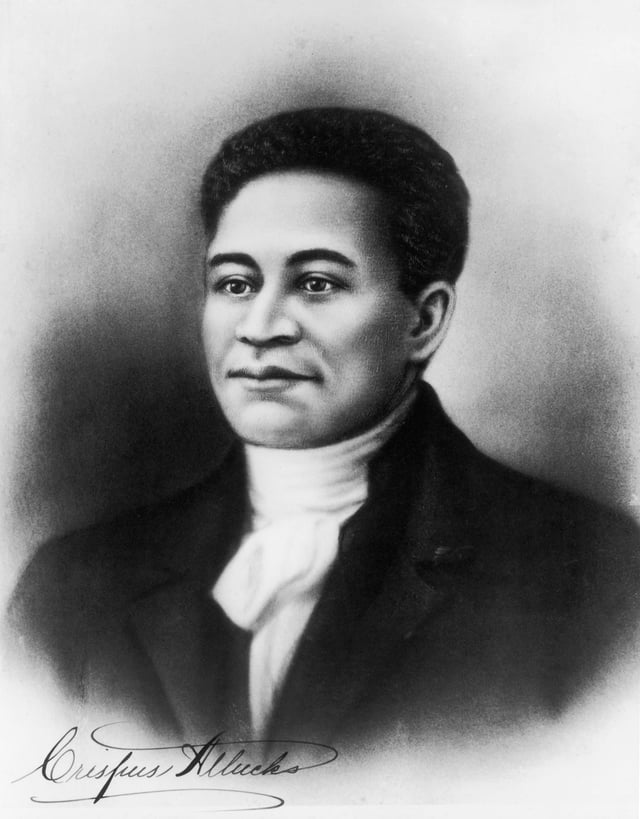
Crispus Attucks was an iconic patriot; he was fatally shot by British soldiers in the Boston Massacre of 1770 and is thus considered the first American killed in the Revolution
Free blacks in the North and South fought on both sides of the Revolution, but most fought for the Patriots. Gary Nash reports that there were about 9,000 black Patriots, counting the Continental Army and Navy, state militia units, privateers, wagoneers in the Army, servants to officers, and spies.[168] Ray Raphael notes that thousands did join the Loyalist cause, but "a far larger number, free as well as slave, tried to further their interests by siding with the patriots."[169] Crispus Attucks was shot dead by British soldiers in the Boston Massacre in 1770 and is considered the first American casualty of the Revolutionary War.
Many black slaves sided with the Loyalists. Tens of thousands in the South used the turmoil of war to escape, and the southern plantation economies of South Carolina and Georgia were disrupted in particular. During the Revolution, the British tried to turn slavery against the Americans.[170] Historian David Brion Davis explains the difficulties with a policy of wholesale arming of the slaves:
But England greatly feared the effects of any such move on its own West Indies, where Americans had already aroused alarm over a possible threat to incite slave insurrections. The British elites also understood that an all-out attack on one form of property could easily lead to an assault on all boundaries of privilege and social order, as envisioned by radical religious sects in Britain's seventeenth-century civil wars.[171]
Davis underscores the British dilemma: "Britain, when confronted by the rebellious American colonists, hoped to exploit their fear of slave revolts while also reassuring the large number of slave-holding Loyalists and wealthy Caribbean planters and merchants that their slave property would be secure".[172] The Colonists, however, accused the British of encouraging slave revolts.[173]
American advocates of independence were commonly lampooned in Great Britain for what was termed their hypocritical calls for freedom, at the same time that many of their leaders were planters who held hundreds of slaves. Samuel Johnson snapped, "how is it we hear the loudest yelps for liberty among the drivers of the Negroes?"[174] Benjamin Franklin countered by criticizing the British self-congratulation about "the freeing of one Negro" named Somersett while they continued to permit the overall slave trade.[175] Phyllis Wheatley was a black poet who popularized the image of Columbia to represent America. She came to public attention when her Poems on Various Subjects, Religious and Moral appeared in 1773.[176]
The effects of the war were more dramatic in the South. In Virginia, royal governor Lord Dunmore recruited black men into the British forces with the promise of freedom, protection for their families, and land grants. Tens of thousands of slaves escaped to British lines throughout the South, causing dramatic losses to slaveholders and disrupting cultivation and harvesting of crops. For instance, South Carolina was estimated to have lost about 25,000 slaves to flight, migration, or death—amounting to one third of its slave population. From 1770 to 1790, the black proportion of the population (mostly slaves) in South Carolina dropped from 60.5 percent to 43.8 percent, and from 45.2 percent to 36.1 percent in Georgia.[177]
British forces gave transportation to 10,000 slaves when they evacuated Savannah and Charleston, carrying through on their promise.[178] They evacuated and resettled more than 3,000 Black Loyalists from New York to Nova Scotia, Upper Canada, and Lower Canada. Others sailed with the British to England or were resettled as freedmen in the West Indies of the Caribbean. But slaves who were carried to the Caribbean under control of Loyalist masters generally remained slaves until British abolition in its colonies in 1834. More than 1,200 of the Black Loyalists of Nova Scotia later resettled in the British colony of Sierra Leone, where they became leaders of the Krio ethnic group of Freetown and the later national government. Many of their descendants still live in Sierra Leone, as well as other African countries.[179]
Effects of the Revolution
Loyalist expatriation
Tens of thousands of Loyalists left the United States; Maya Jasanoff restimates 70,000.[180] Some migrated to Britain. The great majority received land and subsidies for resettlement in British colonies in North America, known as United Empire Loyalists, especially Quebec (concentrating in the Eastern Townships), Prince Edward Island, and Nova Scotia.[181] Britain created the colonies of Upper Canada (Ontario) and New Brunswick expressly for their benefit, and the Crown awarded land to Loyalists as compensation for losses in the United States. Britain wanted to develop the frontier of Upper Canada on a British colonial model. But about 85% of the Loyalists stayed in the United States and became full, loyal citizens; some of the exiles later returned to the U.S.[182]
Interpretations
Historians such as Bernard Bailyn, Gordon Wood, and Edmund Morgan view the American Revolution as a unique and radical event that produced deep changes and had a profound effect on world affairs, such as an increasing belief in the principles of the Enlightenment. These were demonstrated by a leadership and government that espoused protection of natural rights, and a system of laws chosen by the people.[185] John Murrin, by contrast, argues that the definition of "the people" at that time was mostly restricted to free men who were able to pass a property-qualification.[186][187] This view argues that any significant gain of the revolution was irrelevant in the short term to women, black Americans and slaves, poor white men, youth, and American Indians.[188][189]
Morgan has argued that, in terms of long-term impact on American society and values:
- The Revolution did revolutionize social relations. It did displace the deference, the patronage, the social divisions that had determined the way people viewed one another for centuries and still view one another in much of the world. It did give to ordinary people a pride and power, not to say an arrogance, that have continued to shock visitors from less favored lands. It may have left standing a host of inequalities that have troubled us ever since. But it generated the egalitarian view of human society that makes them troubling and makes our world so different from the one in which the revolutionists had grown up.[190]
Inspiring all colonies
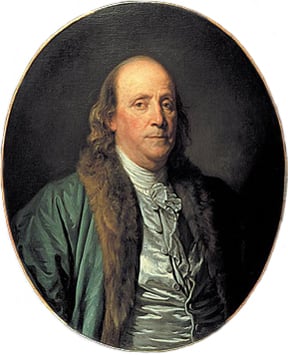
1777 Jean-Baptiste Greuze portrait of Ben Franklin
After the Revolution, genuinely democratic politics became possible in the former colonies.[191] The rights of the people were incorporated into state constitutions. Concepts of liberty, individual rights, equality among men and hostility toward corruption became incorporated as core values of liberal republicanism. The greatest challenge to the old order in Europe was the challenge to inherited political power and the democratic idea that government rests on the consent of the governed. The example of the first successful revolution against a European empire, and the first successful establishment of a republican form of democratically elected government, provided a model for many other colonial peoples who realized that they too could break away and become self-governing nations with directly elected representative government.[192]
The Dutch Republic, also at war with Britain, was the next country to sign a treaty with the United States, on October 8, 1782.[66] On April 3, 1783, Ambassador Extraordinary Gustaf Philip Creutz, representing King Gustav III of Sweden, and Benjamin Franklin, signed a Treaty of Amity and Commerce with the U.S.[66]
The American Revolution was the first wave of the Atlantic Revolutions: the French Revolution, the Haitian Revolution, and the Latin American wars of independence. Aftershocks reached Ireland in the Irish Rebellion of 1798, in the Polish–Lithuanian Commonwealth, and in the Netherlands.[193][194]
The Revolution had a strong, immediate influence in Great Britain, Ireland, the Netherlands, and France. Many British and Irish Whigs spoke in favor of the American cause. In Ireland, there was a profound impact; the Protestants who controlled Ireland were demanding more and more self-rule. Under the leadership of Henry Grattan, the so-called "Patriots" forced the reversal of mercantilist prohibitions against trade with other British colonies. The King and his cabinet in London could not risk another rebellion on the American model, and made a series of concessions to the Patriot faction in Dublin. Armed Protestant volunteer units were set up to protect against an invasion from France. As in America, so too in Ireland the King no longer had a monopoly of lethal force.[195]
The Revolution, along with the Dutch Revolt (end of the 16th century) and the 17th century English Civil War, was among the examples of overthrowing an old regime for many Europeans who later were active during the era of the French Revolution, such as the Marquis de Lafayette. The American Declaration of Independence influenced the French Declaration of the Rights of Man and the Citizen of 1789.[196][197] The spirit of the Declaration of Independence led to laws ending slavery in all the Northern states and the Northwest Territory, with New Jersey the last in 1804. States such as New Jersey and New York adopted gradual emancipation, which kept some people as slaves for more than two decades longer.[198]
Status of American women
The democratic ideals of the Revolution inspired changes in the roles of women.[199]
The concept of republican motherhood was inspired by this period and reflects the importance of Republicanism as the dominant American ideology. It assumed that a successful republic rested upon the virtue of its citizens. Women were considered to have the essential role of instilling their children with values conducive to a healthy republic. During this period, the wife's relationship with her husband also became more liberal, as love and affection instead of obedience and subservience began to characterize the ideal marital relationship. In addition, many women contributed to the war effort through fundraising and running family businesses in the absence of husbands.
The traditional constraints gave way to more liberal conditions for women. Patriarchy faded as an ideal; young people had more freedom to choose their spouses and more often used birth control to regulate the size of their families. Society emphasized the role of mothers in child rearing, especially the patriotic goal of raising republican children rather than those locked into aristocratic value systems. There was more permissiveness in child-rearing. Patriot women married to Loyalists who left the state could get a divorce and obtain control of the ex-husband's property.[200] Whatever gains they had made, however, women still found themselves subordinated, legally and socially, to their husbands, disfranchised and usually with only the role of mother open to them. But, some women earned livelihoods as midwives and in other roles in the community, which were not originally recognized as significant by men.
Abigail Adams expressed to her husband, the president, the desire of women to have a place in the new republic: "I desire you would remember the Ladies, and be more generous and favourable to them than your ancestors. Do not put such unlimited power into the hands of the Husbands."[201]
The Revolution sparked a discussion on the rights of woman and an environment favorable to women's participation in politics. Briefly the possibilities for women's rights were highly favorable, but a backlash led to a greater rigidity that excluded women from politics.[202]
For more than thirty years, however, the 1776 New Jersey State Constitution gave the vote to "all inhabitants" who had a certain level of wealth, including unmarried women and blacks (not married women because they could not own property separately from their husbands), until in 1807, when that state legislature passed a bill interpreting the constitution to mean universal white male suffrage, excluding paupers.[203]
Status of African Americans
In the first two decades after the American Revolution, state legislatures and individuals took actions to free numerous slaves, in part based on revolutionary ideals. Northern states passed new constitutions that contained language about equal rights or specifically abolished slavery; some states, such as New York and New Jersey, where slavery was more widespread, passed laws by the end of the 18th century to abolish slavery by a gradual method; in New York, the last slaves were freed in 1827.
While no southern state abolished slavery, for a period individual owners could free their slaves by personal decision, often providing for manumission in wills but sometimes filing deeds or court papers to free individuals. Numerous slaveholders who freed their slaves cited revolutionary ideals in their documents; others freed slaves as a reward for service. Records also suggest that some slaveholders were freeing their own mixed-race children, born into slavery to slave mothers.
Commemorations

Bicentennial logo
The American Revolution has a central place in the American memory[204] as the story of the nation's founding. It is covered in the schools, memorialized by a national holiday, and commemorated in innumerable monuments. George Washington's estate at Mount Vernon was one of the first national pilgrimages for tourists and attracted 10,000 visitors a year by the 1850s.[205]
The Revolution became a matter of contention in the 1850s in the debates leading to the American Civil War (1861–65), as spokesmen of both the Northern United States and the Southern United States claimed that their region was the true custodian of the legacy of 1776.[206] The United States Bicentennial in 1976 came a year after the American withdrawal from the Vietnam War, and speakers stressed the themes of renewal and rebirth based on a restoration of traditional values.[207]
Today, more than 100 battlefields and historic sites of the American Revolution are protected and maintained by the government. The National Park Service alone owns and maintains more than 50 battlefield parks and sites related to the Revolution.[208] The American Battlefield Trust preserves almost 700 acres of battlefield land in six states.[209][210]
See also
Bibliography of the American Revolutionary War
Bibliography of George Washington
Bibliography of Thomas Jefferson
Timeline of the American Revolution
Diplomacy in the American Revolutionary War
List of George Washington articles
List of plays and films about the American Revolution
List of television series and miniseries about the American Revolution